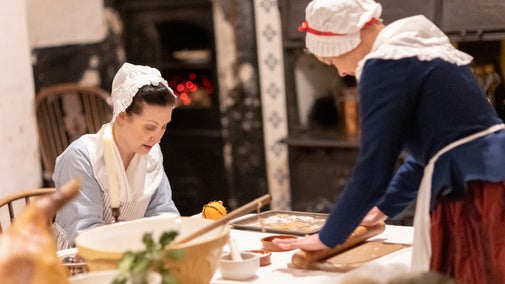
Discover more at Castle Ward
Find out when Castle Ward is open, how to get here, the things to see and do and more.

Castle Ward is a unique 18th-century mansion famed for its mixture of architectural styles and interiors. One half is built in the classical Palladian style, while the other half – which faces out across Strangford Lough – is built in the more elaborate Gothic style.
The story told for the reason behind this unusual decorative scheme is that the builder of the house, Bernard Ward, 1st Viscount Bangor, did not agree with his wife Lady Anne on the décor. Bernard had a classical taste but Lady Anne preferred the fashionable Gothic style, leading them to split the house down the middle.
Despite the decision to accommodate both tastes, the couple separated not long after the house was finished, with Anne leaving Castle Ward for good.

When Bernard and Lady Anne inherited the estate in 1759 they set about building themselves a fine new house. It would be symbolic of their union and exist as a statement of the Ward family's bold and forward-thinking place in the world. Castle Ward was completed in 1766 and by 1781 they had been created Viscount and Viscountess Bangor in the Peerage of Ireland.
Lady Anne's grandfather was the nephew of the Duchess of York – wife of King James II and a first cousin of Queen Anne. This royal ancestry shows itself in the choice of the Gothic style. The ceiling in the Morning Room is copied from the Henry VII Chapel in Westminster Abbey, where Anne's maternal family were permitted to be buried due to their royal blood.
Rather than the house becoming known as an architectural monstrosity, the couple aimed for it to be a masterpiece, striving against convention and rooting the Ward family as bold, modern thinkers with an impressive past.
Temple Water, too, is an important piece of Castle Ward's history. Canals like this became fashionable among landowners in Ireland at this time, however today it is one of the very few to survive. The man-made landscape of the Temple Water area, designed by the Ward family, is one of the most important late 17th- and early 18th-century gardens remaining in Ireland.
The canal was built in 1728 by Judge Michael Ward. It created a formal landscape and was designed to reflect the picturesque ruins of Audley Castle at one end and Lady Anne's Temple along one side. The canal is 530 metres long and is the largest ornamental garden feature to survive in Ireland from the early 18th century.
The unusual combination of styles has long been a point of joy or novelty for visitors, having a 'Marmite' effect. On a visit to Castle Ward, writer and poet John Betjeman referred to the ceiling in the Boudoir as 'like sitting under a cow's udder', and the comment has stuck. Others comment on the otherworldly feeling created by the exotic grandeur of the Gothic side.

The idea of having a 'home of one's own' as we understand it today is an inherently Georgian ideal, as illustrated through this extraordinary and unusual house of two sides.
While Bernard and Lady Anne had differing tastes in architecture, the idea of creating a home which was expressive of their tastes and passions was paramount.
If we look at Castle Ward's Collection we can see how the couple used family crests, armorials, coronets and monogramming on all manner of objects to reinforce the idea that this place was special to them.
The Collection has been altered in some ways and enhanced and added to by successive generations of the Ward family. But each family member has continued to reinforce the fact that this was very much their home and a place where they could find self-expression.
One such expression of Bernard and Lady Anne's passions is a carved panel in the dining room depicting Demeter, the goddess of agriculture and harvests. The panel’s alter-like position adds to the symbolic nature of the piece and reflects the importance of a successful harvest to the family.
The panel apparently had the desired effect – following a visit to Castle Ward in the autumn of 1772, Sir James Caldwell described a table overflowing with cooked meats, fish and exotic fruits:
– Sir James Caldwell

Find out when Castle Ward is open, how to get here, the things to see and do and more.

Discover the stories of some of the most notable people who have lived at Castle Ward over the centuries, from one of the mansion’s creators to a celebrated war correspondent.

Wander through the Georgian rooms of this eccentric mansion, famed for its contrasting architecture and interiors, and explore the servants' world below stairs.

Find out about some of the conservation work that staff and volunteers carry out throughout the year to preserve the Castle Ward mansion and estate for everyone, for ever.

Learn about people from the past, discover remarkable works of art and brush up on your knowledge of architecture and gardens.

From landscape gardeners to LGBTQ+ campaigners and suffragettes to famous writers, many people have had their impact on the places we care for. Discover their stories and the lasting legacies they’ve left behind.

Explore the objects and works of art we care for at Castle Ward on the National Trust Collections website.